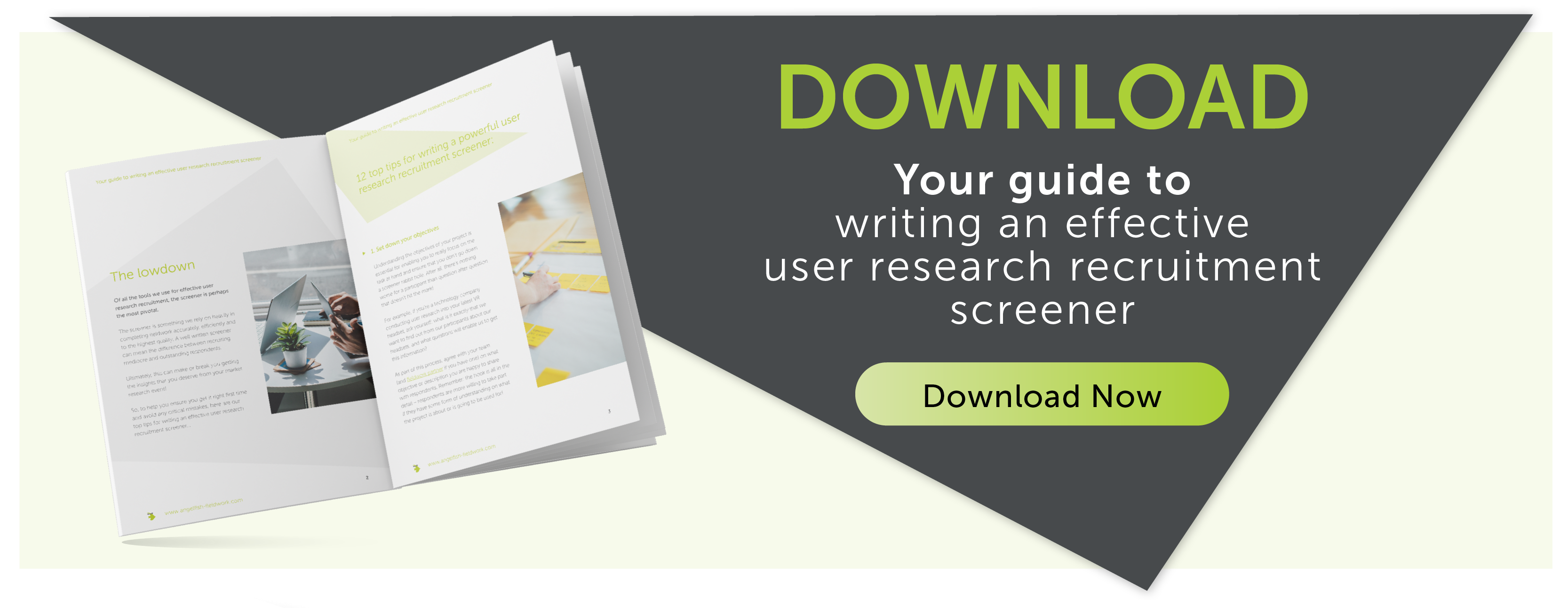What is a user research recruitment screener, and how should you write one?
Your participants are what makes your user research a success – but this can’t happen without an effective screener.
But what is a user research recruitment screener, you ask?
A screener is perhaps the most pivotal ingredient in recruitment, and is a tool we heavily rely on in completing fieldwork accurately, efficiently and to the highest quality.
In a nutshell, a screener is a set of qualifying questions that will enable you to verify whether a participant is the right fit for the research you want to carry out. These are usually conducted over the phone, or online.
What is the typical structure of a participant screener?
These questions go beyond your participants’ basic demographics such as age, gender identity and location to a more specific investigation into your particular sector.
Generally, the questions on a market research recruitment screener fall into the following categories:
1. Demographics
There are a number of different demographics you can collect about your participants in order to decide whether they’re the right person to take part in your research. Just some of these include the following:
- Age/life cycle stage
- Social grade
- Sex/gender identity
- Ethnicity
- Occupation
- Income
- Marital status
- Whether they have children or not
- Geographical location
(It’s worth noting that you should include a “Prefer not to answer” option for any particularly sensitive questions!)
2. Behaviours
This section of the user research recruitment screener explores how your participants behave in certain scenarios, as well as their decision-making processes.
If your market research is centred around charitable giving, for example, the behavioural section of your screener could include questions such as the following:
- How often do you donate to charities?
- How do you prefer to make charitable donations?
3. Screen-outs (industry and product/service-specific)
This section enables you to screen out any participants that may cause a bias in your research due to working in a similar industry, who work in competitor companies that offer similar products and services, or who work in the market research sector themselves.
4. Digital and physical accessibility
Before the sudden influx of technology, the majority of market research projects took place face-to-face, and a good number still do. The screener is therefore a good opportunity to check whether it will be feasible for a participant to access your chosen venue.
Today, with so many market research projects happening in the online sphere, it’s also important to check that prospective participants have access to the right tech, such as phones, tablets and computers in order to complete the research, as well as a stable internet connection.
5. Confidentiality
The screener is also a great place to inform your participants that their participation in the study will remain confidential, and that they will have the right to withdraw from the research at any time.
Why is an effective screener so important to your market research?
A well written screener can mean the difference between recruiting mediocre and outstanding respondents.
If your screener is poorly designed, you’re unlikely to find the calibre of participants you need for your study. Not only will this result in lost time and money, but if the research goes ahead with the wrong participant pool, your results could be skewed, biased, or tell you nothing at all. Read more on avoiding critical mistakes in user research.
Ultimately, the screener can make or break you getting the data and insights that you deserve from your market research event!
So, now we’ve established what a user research recruitment screener is and outlined what it typically includes, the next question is...
How can you write an effective user research participant screener?
Our free, comprehensive guide Your guide to writing an effective user research recruitment screener explores the answer to this in more detail, including our in-house know-how on:
- knowing your audience inside out
- creating a seamless structure
- asking the right kind of questions
- adding that all-essential human touch
- making the questionnaire an appropriate length
- and much more.
Don't miss: 7 Questions Every User Research Recruitment Screener Should Include
Ready to get started?
Now you know what a user research recruitment screener is and the elements this should include, it’s time to get writing!
Download our free guide now to ensure you get your market research project off on the right foot.
We also offer screener writing as part of our expert market research recruitment services here at Angelfish Fieldwork. Get in touch with us today to find out more...








